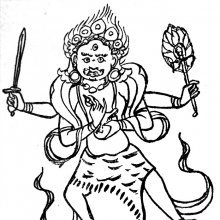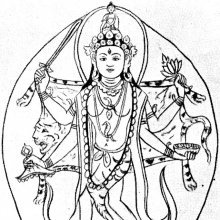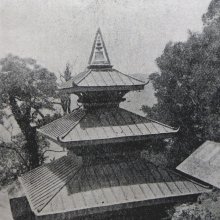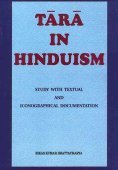Ugratara, Ugra-tara, Ugratārā: 7 definitions
Introduction:
Ugratara means something in Buddhism, Pali, Hinduism, Sanskrit. If you want to know the exact meaning, history, etymology or English translation of this term then check out the descriptions on this page. Add your comment or reference to a book if you want to contribute to this summary article.
Images (photo gallery)
In Hinduism
Shaktism (Shakta philosophy)
Source: Sacred Texts: Hymns to the GoddessUgratārā (उग्रतारा) is another name for Tara or Tāriṇī.—The Matsyasūkta, Tārārṇava, and Nīla Tantras deal with particulars or Tārā or Tāriṇī, one of the Mahāvidyā, whose bīja is Hrīm Strīm, Hūm (Kurccha), Phat. She is called Nīlasarasvatī, because She playfully gives the power of speech. She is called Tārā on account of her being deliverer or saviour (tārakatvāt). She gives both pleasure (sukha) and liberation (mokṣa). She is called also Ugratārā, because She saves from formidable and horrible calamities. Ṛṣi Vasiṣṭha [Vaśiṣṭha] is said to have cursed this vidyā, and then raised the curse so that siddhi might be gained from Her by japa of the Bīja Hrīm, Strīm, Hūm, Phat, after which She again became glorious.

Shakta (शाक्त, śākta) or Shaktism (śāktism) represents a tradition of Hinduism where the Goddess (Devi) is revered and worshipped. Shakta literature includes a range of scriptures, including various Agamas and Tantras, although its roots may be traced back to the Vedas.
In Buddhism
Tibetan Buddhism (Vajrayana or tantric Buddhism)
Source: archive.org: The Indian Buddhist IconographyUgratārā (उग्रतारा) is another name for Mahācīnatārā: one of the female emanations of Akṣobhya, as mentioned in the 5th-century Sādhanamālā (a collection of sādhana texts that contain detailed instructions for rituals).—Her Āsana is the pratyālīḍha; her Appearance is terrible; her Vāhana is the corpse; she has four arms.—Mahācīnatārā is also known in Buddhist Tantric literature as Ugratārā, and the Vajrayogini temple at Śāṅku in Nepal, contains in the sanctum a figure of Ugratārā. This Ugratārā or Mahācīnatārā of the Buddhists has been incorporated in the Hindu pantheon under the name of Tārā, and is now regarded as one of the ten Mahāvidyā goddesses.

Tibetan Buddhism includes schools such as Nyingma, Kadampa, Kagyu and Gelug. Their primary canon of literature is divided in two broad categories: The Kangyur, which consists of Buddha’s words, and the Tengyur, which includes commentaries from various sources. Esotericism and tantra techniques (vajrayāna) are collected indepently.
Languages of India and abroad
Sanskrit dictionary
Source: DDSA: The practical Sanskrit-English dictionaryUgratārā (उग्रतारा).—Name of a goddess.
Ugratārā is a Sanskrit compound consisting of the terms ugra and tārā (तारा).
Source: Cologne Digital Sanskrit Dictionaries: Monier-Williams Sanskrit-English DictionaryUgratārā (उग्रतारा):—[=ugra-tārā] [from ugra] f. Name of a goddess, [Kālikā-purāṇa]
[Sanskrit to German]
Sanskrit, also spelled संस्कृतम् (saṃskṛtam), is an ancient language of India commonly seen as the grandmother of the Indo-European language family (even English!). Closely allied with Prakrit and Pali, Sanskrit is more exhaustive in both grammar and terms and has the most extensive collection of literature in the world, greatly surpassing its sister-languages Greek and Latin.
Nepali dictionary
Source: unoes: Nepali-English DictionaryUgratārā (उग्रतारा):—n. 1. one of the Mahavidyas (महाविद्या [mahāvidyā ] : Great Wisdoms); 2. a famous star; 3. Mythol. an epithet of the goddess;
Nepali is the primary language of the Nepalese people counting almost 20 million native speakers. The country of Nepal is situated in the Himalaya mountain range to the north of India.
See also (Relevant definitions)
Starts with: Ugratarakavaca, Ugratarapaddhati, Ugratarapancanga, Ugratarapujapaddhati, Ugratarasahasranaman, Ugratarastotra.
Query error!
Full-text: Ugratarastotra, Ugratarapaddhati, Ugra, Gauhati, Ekajata, Uttaramnaya, Tarini, Nilatantra, Matsyasukta, Tararnavatantra, Tararnava, Nilasarasvati, Matsyasuktatantra, Tarakatvat, Mahacinatara, Tara.
Relevant text
Search found 14 books and stories containing Ugratara, Ugra-tara, Ugra-tārā, Ugratārā; (plurals include: Ugrataras, taras, tārās, Ugratārās). You can also click to the full overview containing English textual excerpts. Below are direct links for the most relevant articles:
Iconography of Buddhist and Brahmanical Sculptures (by Nalini Kanta Bhattasali)
Devi Tantra, Mantra, Yantra (study) (by Srider Basudevan Iyer)
Description of Goddess Kali < [Chapter 3 - Minor Goddesses]
Temples of Purushottama Kshetra Puri (by Ratnakar Mohapatra)
12. Hara Candi Temple (in Puri) < [Chapter 6 - Shakta Temples of Purushottama Kshetra]
5. Sarva-Mangala Temple (in Puri) < [Chapter 6 - Shakta Temples of Purushottama Kshetra]
9. Daksinakali or Dakshinkali Temple (in Puri) < [Chapter 6 - Shakta Temples of Purushottama Kshetra]
The Indian Buddhist Iconography (by Benoytosh Bhattachacharyya)
Figure 135-136 - Emanations of Akṣobhya: Mahācīna Tārā (Ugratārā)
Notices of Sanskrit Manuscripts (by Rajendralala Mitra)
Tantra Pithas of Orissa (Study) (by Balaram Panda M. A.)
Related products



